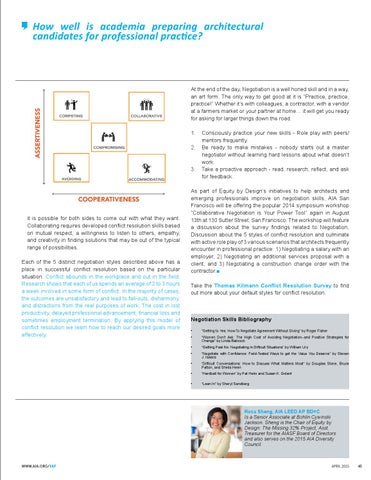How well is academia preparing architectural candidates for professional practice?
At the end of the day, Negotiation is a well honed skill and in a way, an art form. The only way to get good at it is “Practice, practice, practice!” Whether it’s with colleagues, a contractor, with a vendor at a farmers market or your partner at home… it will get you ready for asking for larger things down the road. 1. Consciously practice your new skills - Role play with peers/ mentors frequently. 2. Be ready to make mistakes - nobody starts out a master negotiator without learning hard lessons about what doesn’t work. 3. Take a proactive approach - read, research, reflect, and ask for feedback.
it is possible for both sides to come out with what they want. Collaborating requires developed conflict resolution skills based on mutual respect, a willingness to listen to others, empathy, and creativity in finding solutions that may be out of the typical range of possibilities. Each of the 5 distinct negotiation styles described above has a place in successful conflict resolution based on the particular situation. Conflict abounds in the workplace and out in the field. Research shows that each of us spends an average of 2 to 3 hours a week involved in some form of conflict. In the majority of cases, the outcomes are unsatisfactory and lead to fall-outs, disharmony, and distractions from the real purposes of work. The cost in lost productivity, delayed professional advancement, financial loss and sometimes employment termination. By applying this model of conflict resolution we learn how to reach our desired goals more effectively.
As part of Equity by Design’s initiatives to help architects and emerging professionals improve on negotiation skills, AIA San Francisco will be offering the popular 2014 symposium workshop “Collaborative Negotiation is Your Power Tool” again in August 13th at 130 Sutter Street, San Francisco. The workshop will feature a discussion about the survey findings related to Negotiation, Discussion about the 5 styles of conflict resolution and culminate with active role play of 3 various scenarios that architects frequently encounter in professional practice: 1) Negotiating a salary with an employer, 2) Negotiating an additional services proposal with a client, and 3) Negotiating a construction change order with the contractor.■ Take the Thomas Kilmann Conflict Resolution Survey to find out more about your default styles for conflict resolution.
Negotiation Skills Bibliography •
“Getting to Yes: How To Negotiate Agreement Without Giving” by Roger Fisher
•
“Women Don’t Ask: The High Cost of Avoiding Negotiation--and Positive Strategies for Change” by Linda Babcock
•
“Getting Past No: Negotiating in Difficult Situations” by William Ury
•
“Negotiate with Confidence: Field-Tested Ways to get the Value You Deserve” by Steven J. Isaacs
•
“Difficult Conversations: How to Discuss What Matters Most” by Douglas Stone, Bruce Patton, and Sheila Heen
•
“Hardball for Women” by Pat Heim and Susan K. Golant
•
“Lean In” by Sheryl Sandberg
Rosa Sheng, AIA LEED AP BD+C Is a Senior Associate at Bohlin Cywinski Jackson. Sheng is the Chair of Equity by Design: The Missing 32% Project, Asst. Treasurer for the AIASF Board of Directors and also serves on the 2015 AIA Diversity Council.
WWW.AIA.ORG/YAF
APRIL 2015
45
